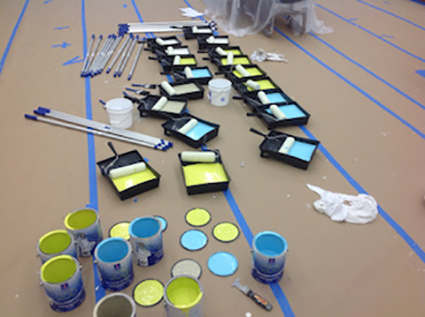Different Types of Paint

Pennsylvania Homes, a brokerage website serving the Pennsylvania area, interviewed us about the different types of paint and other paint-related topics. Check out our interview below:
My interview, Different Types of Paint on Pennsylvania Homes
OR Read it below:
PH: What different types of paints are on the market today?
For interior walls we tend to use water based paints like low-VOC Duration Home brand paint and zero-VOC Harmony brand paint made by Sherwin-Williams. Water based paints advantages: cleanup with water, quick drying, an elastic, flexible finish resistant to cracking, stable color over time, without yellowing There are oil based paints, used primarily for glossy woodwork, doors, and furniture, as well as floors. They tend to have an attractive gloss, good brush strokes creating a smooth finish, hard, durable finish The majority of wall paint sold today is water-based.
PH: What sheen of paint is best for the following: walls, trim, doors, and ceilings?
Matte paint: • is the least reflective sheen available • has a velvety texture • helps hides imperfections in walls and ceilings • offers great depth of color • is generally considered the standard sheen for walls • can sometimes be difficult to clean.
Eggshell and satin paint (satin is slightly glossier than eggshell): • have some reflectivity • offer improved durability • are frequently used in demanding environments, like kitchens and bathrooms, where easy cleanup without a highly glossy finish is desired Semi-gloss and gloss paint: • are the most reflective sheens • are highly durable and stand up to multiple cleanings • are traditionally used on baseboards, moldings, and doors • can make a statement, but also highlight imperfections.
PH: Is there really a difference between the quality of paint and the brand?
Quality Paint = Good Brand like Benjamin Moore and Sherwin Williams. There is a difference between cheap paint brands like Behr and premium paint brands like BM or SW. Three components to the quality and the longevity of a paint job. Prep: It’s all about the prep, the more prep the better the paint job will look and the longer it will last. Labor: The better the painter the better the paint job will look and the longer it will last. Paint: the better the quality of the paint the better it will look and the longer it will last. There are four key ingredients that effect the quality of a paint are: binders, liquids, additives and pigments. Higher-quality paints have more of the most important and more expensive prime pigments, which in the end gives you easier application as well as better color retention and better durability. The better binders help your paint adhere to surfaces better, this makes them more resistant to cracking and peeling. Additives like mildewicides give paint a specific benefit. Liquids are the carrier that allows you to get the paint from the can to the painting surface. Top quality paints have a greater ratio of solids (pigments and binders) to liquids, but the cheaper paints are more watered down with liquid. High quality paints cover the old paint job much better, with less work and less retouching required, which can also mean fewer coats.
No Brush Marks or Roller Marks – High quality paints go on much more smoothly then the cheap paints do, which results in a cleaner and more consistent appearance.
Minimal Splattering – Clean up is much easier with a high quality paint.
Washability – High quality paints have better resistance to dirt and require less maintenance and stay newer looking longer.
Scrubability – Higher quality paints stand up to repeated cleanings without coming off.
Less Burnishing – those nasty shiny marks that you see from rubbing and cleaning, you’ll get far fewer of them with a high quality paint.
